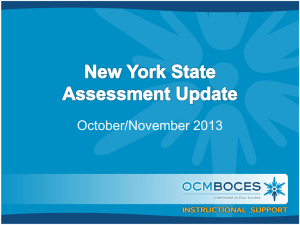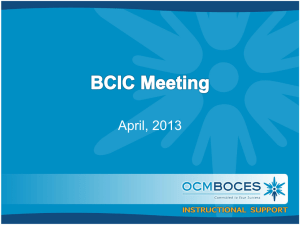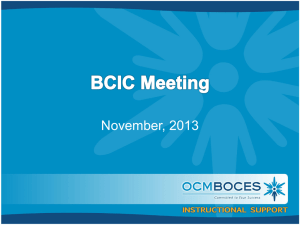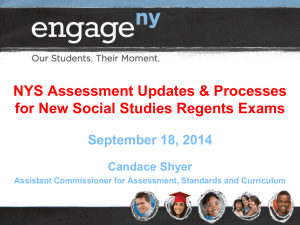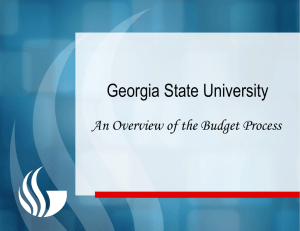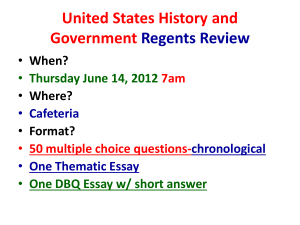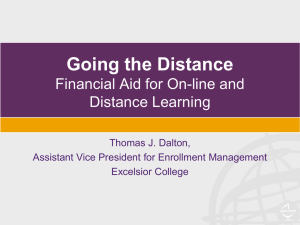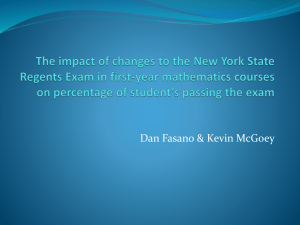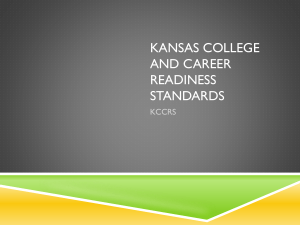Update - OCM Boces
advertisement
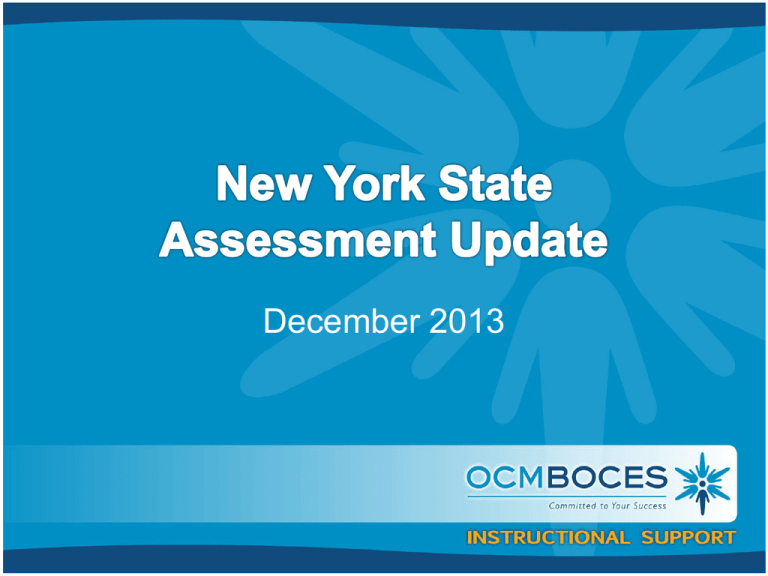
December 2013 3-8 ELA Test • Split into 3 books • Administered across 3 days • Day 2 will consist of one book with both multiple-choice and constructed response questions • Grades 5-8, Day 2 will have fewer passages and questions than Day 2 of the 2013 tests 3-8 Mathematics Test • Fewer questions on the 2014 Grades 3-8 Mathematics Tests than the 2013 tests • Shorter administration times for the 2014 Grade 3-8 Mathematics Tests than in 2013; • Clarifications to the Mathematics rubrics and scoring policies; and • Change in Grade 8 content emphasis 8th Grade Math Testing SED has applied for the waiver to USDOE • Allow A1 proficient score to serve as 8th grade proficient score • Would require an additional math test in High School • This is for THIS year Common Core ELA Regents The Common Core ELA Regents Exam (Grade 11) is required for those students first entering grade 9 in 2013-14 or later Common Core ELA Regents For January, June & August, 2014 administrations only, students enrolled in CC English courses may, at local discretion, take both The Board of Regents altered regulations at the November meeting to allow for the widespread administration of the Regents Comprehensive Examination in January. Common Core ELA Regents The higher of the two scores may be used for local transcript purposes, and will be used for institutional accountability for the 2013-14 school year Students may meet the exam requirement for graduation by passing either exam (old exam or new CC exam) Common Core ELA Regents January survey to ask if districts are planning to have students take CC test in June to find out if enough for standard setting (If yes, how many students?) Regents exams/items will be fully released by summer 2014 so we will see it once administered, not secure for now. Common Core ELA Regents • Part 1 – reading comprehension with 24 questions requiring close reading and an understanding of the whole text, one literary nonfiction, one literature piece and likely one poem. Incorrect answers are text based and plausible and based on likely misconceptions if they didn’t understand full text. • Part 2 – writing from sources different from a DBQ so no comparison, it will not allow for drawing upon outside knowledge, must draw on text only, writing a source based argument. Part 2 is significant emphasis and likely will be weighted as such. • Part 3 – text analysis, not an extended response as in Part 2. Two to three paragraph response that identifies a central idea, authors writing strategy or literary technique Common Core ELA Regents Test Part Suggested Time Standards Addressed (coverage will vary) PART 1 READING COMPREHENSION 60 minutes RL.1-6, 10 RI.1-6, 8-10 L.3-5 PART 2 WRITING FROM SOURCES 90 minutes RL.1-6,10-11 RI.1-10 W.1, 4,9 L.1-6 PART 3 TEXT ANALYSIS 30 minutes RL.1-6, 10 RI.1-6, 8-10 W.2,4,9 L.1-6 Text Description 2 – 3 texts Up to approximately 2,600 words total Student Task Students will perform a close reading of the texts and answer 24 multiple-choice questions. Each test will contain at least one literature and one informational text. 2 – 5 texts Up to approximately 2,600 words total Students will perform a close reading of the texts and write a source-based argument, as directed by the task. Each test will contain at least two informational texts and, in addition, may contain graphics or one literature text. 1 text Up to approximately 1,000 words Each test will contain one literature or one informational text. Students will perform a close reading of the text and write a two to three paragraph response that identifies a central idea in the text and analyzes how the author’s use of one writing strategy (literary element or literary technique or rhetorical device) develops this central idea. Overall, the test requires that students read closely 5-9 texts of up to approximately 6,200 words and that they answer 24 multiple-choice questions, write one source-based argument, and one text-based response that identifies a central idea in the text and analyzes how the author’s use of one writing strategy develops this central idea. The test assesses Common Core Learning Standards in Reading, Writing and Language for the Grade 11-12 span, but, due to the integrative and cumulative nature of the standards, items may also assess standards in earlier grade bands. Exact standard coverage will vary from test to test based on the texts and writing tasks used. Common Core A1 Regents The Common Core Algebra I Regents Exam is required for those students first beginning commencement-level math in 2013-14 or later (so, too, is CCLS-aligned instruction) Other first administrations • Geometry (Common Core) – June 2015 • Algebra II (Common Core) – June 2016 Common Core A1 Regents For the June 2014 , August 2014, and January 2015 administrations only, students enrolled in Common Core classes may take the old ELA or math exam in addition to the new exam and have the higher score count. The June 3, 2014 results for the Regents Exam in AI (CCLS) will NOT be available before the Regents Exam in IA on June 20th Common Core A1 Regents Assessment changes: • Focus on the priority Standards • Fluency according to PARCC • Multiple problems on the came standards • Four good resources: Progressions documents; PARCC Model Content Frameworks; A Story of Functions; Illustrative Mathematics Common Core A1 Regents Test Blueprint Conceptual Category Percent of Exam by Points Number and Quantity 2% - 8% Algebra 50% - 56% Functions 32% - 38% Statistics and Probability 5% - 10% Common Core A1 Regents 2014 Regents Exam Test Design Algebra I Exam Number of Questions Point Value per Question Total Point Value per Section Part I Part II Part III Part IV Total 24 MC 8 CR 4 CR 1 CR 37 2 2 4 6 - 48 16 16 6 86 Common Core Regents Exams Likely to have five levels of distinction rather than the four we have had Resources continue to be posted: • ELA 11 resources • A1 resources • Test guides soon • Transition memo (the September update) PARCC • No PARCC in 2014-2015 • Continue to prepare for computer-based testing • Wider net for field testing volunteers • Release of sample items continues • Maryland now LEA state • Final decision??? PISA • • • • Test is a little different than the others US results unchanged Other countries “moving ahead” Job growth in the industrialized world has almost exclusively been at the top end of the PISA skill distribution,” explained Schleicher, “while routine cognitive skills, the kinds of things that are easy to teach but also easy to digitize and outsource, have seen the steepest decline in demand.” PISA • Poverty matters • Early childhood matters • The highest performing countries are pursing goals and strategies that are different than the US • AFT video PISA – So What? • The most successful students are those who feel real “ownership” of their education • Students feel they personally can make a difference in their own outcomes • Students feel education will make a difference for their future PISA – So What? Culture in the highest performing PISA schools: • Teachers participate in shaping standards and curriculum • Teachers have ample time for continuous professional development • Ample planning and collaboration time • Teachers have ownership of their practice and standards, and hold each other accountable
